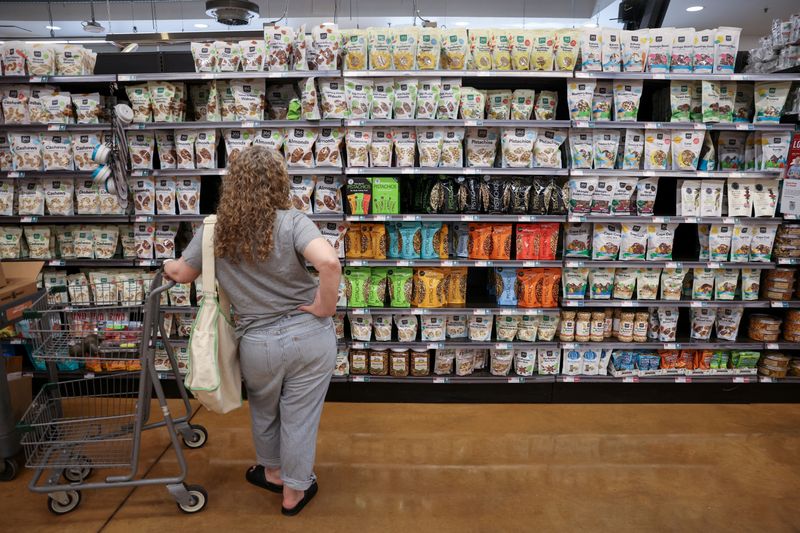By Lucia Mutikani
WASHINGTON (Reuters) -U.S. consumer prices unexpectedly rose in November as a decline in the cost of gasoline was more than offset by increases in rents, further evidence that the Federal Reserve is unlikely to pivot to interest rate cuts early next year.
The report from the Labor Department on Tuesday also showed prices for used cars and trucks rebounded last month after five straight monthly decreases, helping to boost underlying inflation. U.S. consumers also paid more for healthcare and motor vehicle insurance.
The slightly firmer inflation readings followed data last Friday showing job gains accelerated in November and the unemployment rate fell to 3.7% from nearly a two-year high of 3.9% in October. Officials from the U.S. central bank began a two-day policy meeting on Tuesday.
"Ongoing housing price pressures and their outsized influence on inflation overall tell a large part of the story of why calls for early and rapid Fed monetary policy easing should be viewed with significant scrutiny," said Kurt Rankin, senior economist at PNC Financial (NYSE:PNC) in Pittsburgh, Pennsylvania.
"The Fed will not cut rates until inflation's drivers are well and truly tamed."
The consumer price index (CPI) edged up 0.1% last month after being unchanged in October, the Labor Department's Bureau of Labor Statistics said. Gasoline prices decreased 6.0% after dropping 5.0% in the prior month. But natural gas cost more as did electricity.
Food prices rose 0.2% after gaining 0.3% in October. Grocery food prices ticked up 0.1% amid rises in the costs of cereals and bakery products as well as fruits and vegetables. Meat, fish and eggs, however, cost less.
In the 12 months through November, the CPI increased 3.1% after rising 3.2% in October. Economists polled by Reuters had forecast the CPI would be unchanged on the month and gain 3.1% on a year-on-year basis. The annual increase in consumer prices has slowed from a peak of 9.1% in June 2022.
Inflation remains above the Fed's 2% target. Following the data, financial markets continued to push back expectations of a rate cut to May from March, according to CME Group's (NASDAQ:CME) FedWatch Tool, a process that was set in motion following last week's upbeat news on the labor market.
The Fed is expected to leave rates unchanged on Wednesday, with economists confident that its policy tightening campaign is over. The central bank has raised its policy rate by 525 basis points to the current 5.25%-5.50% range since March 2022.
"Watch for (Fed Chair Jerome) Powell to indicate the Fed is not yet ready to definitively rule out further hikes and to reiterate the Fed will keep rates higher for longer," said Will Compernolle, a macro strategist at FHN Financial in New York.
Stocks on Wall Street were trading higher while the dollar slipped against a basket of currencies. U.S. Treasury prices were mixed.
SERVICES STICKY
Excluding the volatile food and energy components, the CPI increased 0.3% in November after climbing 0.2% in the prior month. The so-called core CPI was lifted by rents, which increased 0.5% after rising 0.3% in the prior month.
Owners' equivalent rent, a measure of the amount homeowners would pay to rent or would earn from renting their property, also rose 0.5% after increasing 0.4% in October.
Rental inflation, however, could moderate considerably next year as the rental vacancy rate increased to more than a two-year high in the third quarter, and there is a large stock of apartment buildings in the pipeline. Independent measures also point to slower rental price growth.
With the cost of rent marching higher, services inflation is becoming sticky. Services prices shot up 0.5% after rising 0.3% in October. Stripping out rents, services inflation jumped 0.6% after advancing 0.3% in the prior month.
Underlying inflation was also lifted by a 1.6% surge in prices of used cars and trucks, which is likely temporary. Wholesale prices for used motor vehicles briefly rose amid worries about the impact of the 1-1/2-month United Auto Workers strike that began in September and ended in late October.
Healthcare costs accelerated 0.6% after climbing 0.3% in October, boosted by increases in the cost of physicians' services and prescription medication. Health insurance costs increased 1.1% after recent changes to the methodology the government uses to calculate prices.
Consumers, however, got relief from cheaper apparel, with prices declining 1.3%, likely the result of deep holiday discounting. Prices for household furnishings and operations fell, as did those of new motor vehicles.
That contributed to the continuation of goods price deflation. Goods prices tumbled 0.7% after declining 0.4% in October. Core goods prices dropped 0.3% after dipping 0.1% in the prior month.
Communication, recreation and airline fares were cheaper. The core CPI increased 4.0% on a year-on-year basis in November after advancing by the same margin in October. Shelter costs, which advanced 6.5%, accounted for nearly 70% of the year-on-year rise in the core CPI.
Despite some firmer details in the CPI, economists were heartened by the overall trend in inflation and expected cooler readings next year. High inflation has contributed to a sharp drop in President Joe Biden's approval ratings and threatens his reelection prospects in 2024.
But consumers' inflation views are improving. A report on Monday from the New York Fed showed consumers' inflation expectations softened considerably in November.
That was reinforced by a survey from the University of Michigan last week showing near-term inflation expectations dropped sharply in December.

The National Federation of Independent Business reported on Tuesday that the share of small business owners raising prices fell in November. But the share planning to increase compensation rose to the highest level in nearly two years, a function of persistent labor shortages.
"While we are still encouraged that inflation will be significantly lower by the end of the coming year, the data is still telling us that the path in getting there might not be as smooth as the market seems to be anticipating," said Richard de Chazal, macro analyst at William Blair in London.